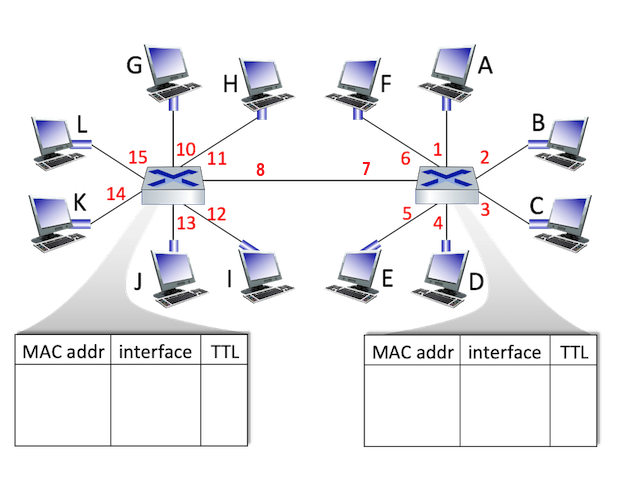Learning Switches - Basic
Consider the LAN below consisting of 10 computers connected by two self-learning Ethernet switches. (You may want to re-read section 6.4.3 in the 8th edition textbook). At t=0 the switch table entries for both switches are empty. At t = 1, 2, 3, and 4, a source node sends to a destination node as shown below, and the destination replies immediately (well before the next time step).

Assume that the following transmissions occur (the transmissions in reply occur but are not shown in the list below):
t=1: L -> I
t=2: A -> B
t=3: J -> H
t=4: J -> I
Fill out the two switch tables and answer the questions below.
Question List
1. At t=1, what is the source entry for switch 1? Format your answer as letter,number or 'n/a'
2. At t=1, what is the destination entry for switch 1? Format your answer as letter,number or 'n/a'
3. At t=1, what is the source entry for switch 2? Format your answer as letter,number or 'n/a'
4. At t=1, what is the destination entry for switch 2? Format your answer as letter,number or 'n/a'
5. At t=2, what is the source entry for switch 1? Format your answer as letter,number or 'n/a'
6. At t=2, what is the destination entry for switch 1? Format your answer as letter,number or 'n/a'
7. At t=2, what is the source entry for switch 2? Format your answer as letter,number or 'n/a'
8. At t=2, what is the destination entry for switch 2? Format your answer as letter,number or 'n/a'
9. At t=3, what is the source entry for switch 1? Format your answer as letter,number or 'n/a'
10. At t=3, what is the destination entry for switch 1? Format your answer as letter,number or 'n/a'
11. At t=3, what is the source entry for switch 2? Format your answer as letter,number or 'n/a'
12. At t=3, what is the destination entry for switch 2? Format your answer as letter,number or 'n/a'
13. At t=4, what is the source entry for switch 1? Format your answer as letter,number or 'n/a'
14. At t=4, what is the destination entry for switch 1? Format your answer as letter,number or 'n/a'
15. At t=4, what is the source entry for switch 2? Format your answer as letter,number or 'n/a'
16. At t=4, what is the destination entry for switch 2? Format your answer as letter,number or 'n/a'
Solution
1. At time t=1, (L,7) is added as an entry to switch table 1.
2. At time t=1, switch table 1 doesn't observe this frame
3. At time t=1, (L,15) is added as an entry to switch table 2.
4. At time t=1, (I,12) is added as an entry to switch table 2.
5. At time t=2, (A,1) is added as an entry to switch table 1.
6. At time t=2, (B,2) is added as an entry to switch table 1.
7. At time t=2, (A,8) is added as an entry to switch table 2.
8. At time t=2, switch table 2 doesn't observe this frame
9. At time t=3, (J,7) is added as an entry to switch table 1.
10. At time t=3, switch table 1 doesn't observe this frame
11. At time t=3, (J,13) is added as an entry to switch table 2.
12. At time t=3, (H,11) is added as an entry to switch table 2.
13. At time t=4, switch table 1 doesn't observe this frame
14. At time t=4, switch table 1 doesn't observe this frame
15. At time t=4, since the entry for computer J in switch table 2 already exists, no new table entry is made
16. At time t=4, since the entry for computer I in switch table 2 already exists, no new table entry is made
That's incorrect
That's correct
The answer was: L,7
The answer was: n/a
The answer was: L,15
The answer was: I,12
The answer was: A,1
The answer was: B,2
The answer was: A,8
The answer was: n/a
The answer was: J,7
The answer was: n/a
The answer was: J,13
The answer was: H,11
The answer was: n/a
The answer was: n/a
The answer was: exists
The answer was: exists